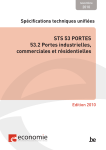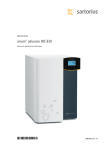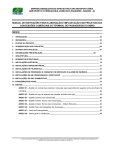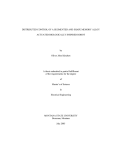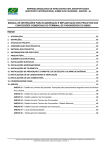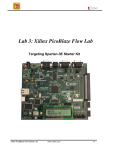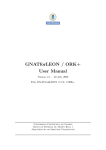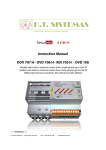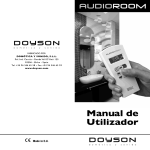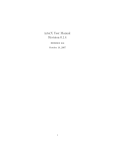Download l||lllllIllllIlllllllllIllllllllllllllllllllll
Transcript
||||l|||||||l|lllllllllllll||l||lllllIllllIlllllllllIllllllllllllllllllllll USO05155451A United States Patent [191 [11] [45] Gladden et al. DYNAMICALLY GENERATING A CLOCK SIGNAL [57] [75] Inventors: Michael E. Gladden; William P. LaViolette, both of Austin, Tex. Oct. 13, 1992 ABSTRACT A clock generator (30) dynamically generates a system clock in response to a high or a low frequency oscilla [73] Assignee: Motorola, Inc., Schaumburg, Ill. tor. An ampli?ed oscillator input is provided to a first input of a multiplexor (62), a divider (56), and a compar ator circuit (58, 60). Divider (56) divides an oscillator input frequency to provide a divided input to a second [21] Appl. No.: 835,834 Feb. 18, 1992 [22] Filed: [51] Int. Cl.5 ........................ .. H03L 7/06; H03L 7/18 [52] US. Cl. ................................... .. 331/1 A; 328/14; input of multiplexer (62). Comparator circuit (58,60) 331/8; 331/14; 331/18; 331/116 FE compares the input frequency with a reference fre quency to determine whether the input frequency is Field of Search ................... .. 331/1 A, l4, 18, 25, high or low. If the input frequency is low, multiplexor 331/8, 116 FE; 328/14 [56] 5,155,451 Primary Examiner-Siegfried H. Grimm Attorney, Agent, or Firm-Jonathan P. Meyer [54] CIRCUIT AND METHOD FOR [58] Patent Number: Date of Patent: (62) is enabled to provide the oscillator input as the system clock. If the input frequency is high, multiplexor References Cited U.S. PATENT DOCUMENTS 4,244,043 4,931,748 l/198l 6/1990 (62) provides the divided input as the system clock. Additionally, comparator circuit (58,60) provides a Fujita et a1. .................... .. 331/14 X McDermott et al. ............ .. 331/1 A control signal to enable an ampli?er (50) to amplify the oscillator input using a high or low gain factor in accor dance with the input frequency. OTHER PUBLICATIONS “MC68332 User’s Manual” published by Motorola, Inc. in 1990, Section 4, pp. 4-4 to 4-53. 21 Claims, 5 Drawing Sheets 54 . GAIN ENABLE XTAL Exmw. AMPLIFIER SYSTEM RESET BUFFER M u TL I I BUi‘FERED FREQUENCY _5_g p REEEQENcE Fgg?g?gY E ‘ g DIVIDER CHAIN 56 — Q R CRYSTAL Q DETECT EDGE DETECT xm.<—————— CLOCK ENABLE FREE)?“ CONTROL DIVIDED g SYSTEM —’ DIYIDER (*4) sYsTEN CLOCKT CLOCK f- 48 _ LIMP MODE ENABLE DETECT - SELECT Q ‘ _f_ PowER 0N RESET “ orfog’EisRET US. Patent Oct. 13, 1992 Sheet 1 of 5 5,155,451 SERIAL I/O PINS l'""-"'___"'_—__?__—_____—___1 l \ SERIAL INTERFACE CPU 16 SIM '------------J )1 EXTERNAL BUS PINS 76 EXTAL >—p > XTAL US. Patent 0a. 13, 1992 Sheet 2 of 5 5,155,451 owjEz mobjd _whoims<“z.o Mm mcuzs<: vm. "M5E0H:. 5 2. m <rm om 205Em30am E5m.L5a mm h-NUB US. Patent Oct. 13, 1992 Sheet 5 of 5 5,155,451 “£2:58 5 5%." 5.5mEn _ k _ m m u _ _ _ _ _ _ r u a _ SmuhzmsoA E85 zSNhoIHw‘-Em;o .m20E_i.mo<a HEMoneu 2m5.~13w.a_ncw>:m a.sm2uz5>o6m zwhmfw am ze mocm.Gmv Ewomu sw.u_m<zow M58 Em a NE . cumwtn Pow-Em V ..@AUNB 1 5,155,451 CIRCUIT AND METHOD FOR DYNAMICALLY GENERATING A CLOCK SIGNAL circuit clock signal generator also includes a control circuit. The control circuit has a ?rst input for receiving the second reference signal and a second input for re ceiving the ampli?ed signal. The control circuit pro- . cesses each of the ampli?ed signal and second reference signal to provide a ?rst control signal. A selector is FIELD OF THE INVENTION This invention relates generally to a data processing system, and more particularly to a clock generator in a data processing system. BACKGROUND OF THE INVENTION 2 processing the ampli?ed signal to provide a second clock signal having a third frequency. The integrated coupled to the ampli?er means, the ?rst logic circuit, 10 and the control circuit for providing the ?rst clock signal at either the ?rst frequency or the third frequency Phase lock loop circuits are well known in the prior art as clock generators which provide stable clock sig in response to the ?rst control signal. These and other features, and advantages, will be more clearly understood from the following detailed nals having predetermined, stable frequencies. The sta bility of each frequency is provided as a result of an iterative process which uses a feedback path to compare description taken in conjunction with the accompany an output of the phase lock loop circuit with an input ing drawings. It is important to note the drawings are not intended to represent the only form of the inven signal typically provided by a crystal oscillator. Many variations of the phase lock loop circuit have been de veloped to provide improvements over known technol— ogy. For example, US Pat. No. 4,931,748 provides a circuit and a method for determining when the input tion. signal provided by the crystal oscillator is no longer present. If the oscillator input to the phase lock loop circuit data processor in accordance with one embodi BRIEF DESCRIPTION OF THE DRAWINGS FIG. 1 illustrates in block diagram form an integrated ment of the present invention; circuit is not detected, a special reference signal is pro FIG. 2 illustrates in partial block diagram form a vided to enable the phase lock loop circuit to continue 25 clock generator of the data processor of FIG. 1; to provide the stable clock signal. FIG. 3 illustrates in partial block diagram form an Although phase lock loop circuits have been substan oscillator generator and ampli?er of the clock generator tially improved, several basic limitations still exist. For of FIG. 2; example, the locking time, or the period of time re FIG. 4 illustrates in circuit diagram form an amplifier quired for a phase lock loop circuit to provide a stable of the oscillator generator and ampli?er of FIG. 3; signal after system start-up, is limited by both a fre FIG. 5 illustrates in timing diagram form a ?rst clock quency and an amplitude of the oscillator input signal. generation operation in oscillator generator and ampli An oscillator input signal with a lower frequency gener ?er of FIG. 3; and ally requires more time to provide a signal having a FIG. 6 illustrates in timing diagram form a second 35 detectable amplitude. Therefore, more time must pass, clock generation operation in oscillator generator and before the oscillator is able to provide a stable signal. ampli?er of FIG. 3. When an oscillator with a frequency of thirty-two kilo hertz is used, a maximum locking time of several sec DETAILED DESCRIPTION OF A PREFERRED onds may be required to provide a stable system clock. EMBODIMENT In many applications, this delay is unacceptable. An The present invention provides a phase lock loop oscillator with a higher frequency may be used to de circuit and method of operation which provide fast crease the locking time to an acceptable period. How locking times with minimal power consumption. Addi ever, when an oscillator with a higher frequency is tionally, the clock generator described herein allows a used, the power consumption of the entire system is increased. 45 user to derive a predetermined system clock signal using one of a plurality of oscillators, each of which Therefore, a need exists for a phase lock loop circuit provides a different frequency. The present invention which decreases locking times for a low frequency allows the user to simply supply a different oscillator to oscillator, but still uses a minimal amount of power. Additionally, a user should not be limited to a single input frequency, but should be provided with the ?exi bility of using one of a plurality of frequencies depend ing on an application of the system in which the phase lock loop circuit is implemented. For example, the user may choose between a phase lock loop circuit which 50 the input of the phase lock loop circuit and does not require additional software or hardware control inputs. Therefore, a user is provided with an uniquely ?exible phase lock loop circuit which dynamically determines an oscillator input frequency and subsequently provides a system clock signal with a minimal amount of power either consumes relatively little power, decreases lock 55 consumption depending on a frequency of the oscillator input. ' ing times for an external oscillator, or both. The terms “assert” and “negate,” and various gram SUMMARY OF THE INVENTION matical forms thereof, are used to avoid confusion when dealing with a mixture of “active high” and “active The previously mentioned needs are ful?lled with the present invention. Accordingly, there is provided, in 60 low” logic signals. “Assert” is used to refer to the ren dering of a logic signal or register bit into its active, or one form, an integrated circuit clock signal generator for receiving a ?rst reference signal at a ?rst frequency logically true, state. “Negate” is used to refer to the and a second reference signal at a second frequency. rendering of a logic signal or register bit into its inac The integrated circuit clock signal generator provides a tive, or logically false state. ?rst clock signal. The integrated circuit clock signal 65 FIG. 1 illustrates one implementation in which the generator includes an ampli?er for receiving and ampli clock generator circuit described herein may be used. In fying the ?rst reference signal to provide an ampli?ed this embodiment, the clock generator circuit provides a signal. A ?rst logic circuit is coupled to the ampli?er for system clock to an integrated circuit data processor 10. 3 5,155,451 Data processor 10 generally includes a oscillator crystal 11, a System Integration Module (SIM) 12, a timer circuit 14, a Central Processing Unit (CPU) 16, a mem ory circuit 18, serial interface 20, and an Inter-Module Bus (IMB) 24. SIM 12, timer circuit 14, CPU 16, mem ory circuit 18, and serial interface 20 are each bi-direc 4 parator 38 compares a frequency of each of the REF ERENCE CLOCK and DIVIDE OUT signals and provides a “PHASE ERROR" signal to an input of charge pump and ?lter 42. Loss of Crystal and Limp Mode Control circuit 36 provides a "FILTER ENABLE” signal and a “LIMP , MODE ENABLE” signal to a ?rst and a second con tionally coupled to IMB 24 to communicate a plurality of address, data, and control signals. Additionally, memory 18 is bi-directionally coupled to timer circuit trol input of charge pump and ?lter 42. Basically, Loss of Crystal and Limp Mode Control circuit 36 indicates when the EXTAL signal is no longer provided to clock generator 30 and a special clock signal should be pro 14 to communicate data and control information. Serial interface 20 is bi-directionally coupled to an external data processor (not shown) via a plurality of serial in put/output (I/O) pins to receive a ?rst plurality of ex ternal information. Similarly, both timer circuit 14 and SIM 12 are bi-directionally coupled to external devices (not shown) via a plurality of timer pins and a plurality of external bus pins, respectively. SIM 12 also receives a VDD signal and a VDDSYN signal to respectively pro vided to enable clock generator 30 to continue to pro vide the SYSTEM CLOCK signal. U. S. Pat. No. 4,93l,748 discusses an implementation of the Loss of Crystal and Limp Mode Control circuit 36 in greater detail and is hereby incorporated herein by reference. If the FILTER ENABLE signal is asserted, charge pump and ?lter 42 ?lters the PHASE ERROR signal and provides a ?ltered output at a ?rst voltage level to crystal 11 receives a signal labelled “XTAL” from and 20 VCO 46. Similarly, if the LIMP MODE ENABLE provides a signal labelled “EXTAL” to SIM 12. signal is asserted, a ?rst logic circuit (not shown) in During operation, SIM 12 generates a plurality of charge pump and ?lter 42 charges and discharges ca clock signals necessary for both data processor 10 and pacitor 44 to provide a stable second voltage level to all peripheral devices coupled to the plurality of exter VCO 46. When either the FILTER ENABLE or nal bus pins to function correctly together. The 25 LIMP MODE ENABLE signals are asserted, capacitor VDDSYN signal is used to provide a separate power 44 and a resistor (not shown) in charge pump and ?lter supply to a clock generator in SIM 12 such that noise 42 function to provide an RC ?lter circuit. The RC and interference problems are reduced. Chapter 4 of the ?lter circuit ensures that the output provided to VCO MC68332 User’s Manual published by Motorola, Inc. of 46 is stable and does not re?ect transients in the PHASE Austin, Tex. in 1990, describes some of the conventional 30 ERROR signal. Additionally, in this implementation of functions performed by SIM 12. However, the the claimed invention, both the FILTER ENABLE MC68332 User’s Manual does not describe the unique and the LIMP MODE ENABLE signals may not be functionality of SIM 12 as described herein. simultaneously asserted. Circuitry necessary to charge FIG. 2 illustrates in partial block diagram form a and discharge capacitor 44 is well-known to one of clock generator 30 of data processor 10 of FIG. 1. This ordinary skill in the art and is, therefore, not explained circuit, as previously mentioned, is located within SIM in detail herein. 12. Clock generator 30 generally includes a divide chain Upon receipt of either the ?ltered output or the limp 32, a prescaler 34, a Loss of Crystal and Limp Mode mode frequency, VCO 46 provides the SYSTEM Control circuit 36, a phase comparator 38, an oscillator CLOCK signal to both external circuitry in data proces generator and ampli?er 40, a charge pump and ?lter 42, sor 10 and to the plurality of peripheral devices coupled a capacitor 44, and a Voltage Controlled Oscillator to the plurality of external bus pins. A frequency of the (V CO) 46. SYSTEM CLOCK signal is determined by a voltage During operation, the EXTAL signal is provided to level of the input of VCO 46. For example, assume the an input of oscillator generator and ampli?er 40. Addi PHASE ERROR signal indicates that the frequency of tionally, the XTAL signal is output to oscillator crystal 45 the REFERENCE CLOCK signal is greater than the 1]. Generation of the XTAL signal is well known to frequency of the DIVIDE OUT signal. Therefore, one of ordinary skill in the art. Oscillator generator and when the PHASE ERROR signal is ?ltered and pro ampli?er 40 provides, as will be more fully described vided to VCO 46, VCO 46 will increase the frequency below, a “REFERENCE CLOCK” signal to a ?rst of the SYSTEM CLOCK signal. The SYSTEM input of phase comparator 38 in response to each of a 50 CLOCK signal is then sealed by prescaler 34 and di “Power On Reset” (POR) signal, a “SYSTEM RE vided to a lower frequency by divide chain 32 to at SET” signal, and a “SYSTEM CLOCK” signal. The tempt to match the frequency of the REFERENCE REFERENCE CLOCK signal is also provided to an CLOCK signal. Similarly, if the frequency of the REF vide a power supply to data processor 10. Oscillator input of Loss of Crystal and Limp Mode Control circuit ERENCE CLOCK signal is less than the frequency of 36. The POR and SYSTEM RESET signals) respec 55 the DIVIDE OUT signal, the ?ltered PHASE ERROR tively provide a ?rst and second control input to oscilla signal will enable VCO 46 to decrease the frequency of tor generator and ampli?er circuit 40. Both the POR the SYSTEM CLOCK signal. and SYSTEM RESET signals are asserted when data In addition to providing the SYSTEM CLOCK sig processor 10 is powered up or reset. The POR signal is nal to external circuitry, VCO 46 also provides the only asserted for a brief period of time at system start-up 60 SYSTEM CLOCK signal to prescaler 34 and to a sec or reset, whereas the SYSTEM RESET signal is as ond oscillator input of oscillator generator and ampli?er serted for a longer period of time to ensure proper sys v 40. Prescaler 34 scales the SYSTEM CLOCK signal tem operation. Additionally, the SYSTEM RESET signal may be asserted by a user of data processor 10 at any point during operation that the user determines data processor 10 should be reset. Divide chain 32 provides an “DIVIDE OUT” signal to a second input of phase comparator 38. Phase com 65 and provides a scaled clock signal to an input of divide chain 32. Divide chain 32 subsequently divides the scaled clock signal by a predetermined frequency to provide the DIVIDE OUT signal at a lower frequency. As was previously stated, the DIVIDE OUT signal is provided to phase comparator 38. 5 5,155,451 6 As is illustrated in FIG. 2, clock generator 30 uses feed-back to control the frequency of the SYSTEM LIMP MODE ENABLE signal is provided to a fourth CLOCK signal provided to external circuitry. The frequency of the SYSTEM CLOCK signal is partially determined by the REFERENCE CLOCK signal pro vided by oscillator generator and ampli?er 40. In this QUENCY and POR signals, divider chain 56 divides the BUFFERED FREQUENCY signal by eight to embodiment of the invention, the REFERENCE frequency. In this implementation of the claimed inven CLOCK signal typically has a frequency of thirty-two kilohertz, an industry standard operating frequency. Typical implementations of clock generators have been developed to provide a predetermined clock frequency tion, divider chain 56 has a divide ratio of eight to di vide a four megahertz oscillator input down to a fre quency of thirty-two kilohertz for use by data process input of clock control circuit 58. In response to each of the BUFFERED FRE provide a DIVIDED FREQUENCY signal at a lower . ing system 10. using an EXTAL signal with a set frequency. However, the locking time of clock generator 30 is dependent on the frequency of the EXTAL signal. For example, if the EXTAL signal has a frequency of thirty-two kilohertz, Additionally, divider chain 56 uses a standard logic circuit (not shown) to test the BUFFERED FRE QUENCY signal to determine whether an oscillator 5 the locking time required to provide a stable SYSTEM CLOCK signal with a minimal amount of power con sumption is typically several seconds, a relatively long period of time in a microprocessing environment. Simi larly, if the EXTAL signal has a frequency of four 20 megahertz, the SYSTEM CLOCK signal is provided in a relatively quick period of time of ?fty milliseconds. However, the faster the frequency of the EXTAL sig nal, the more power a clock generator will consume. Therefore, a system designer must typically choose between quick locking times or low power consump tion when designing a data processing system using conventional clock generator circuitry. Clock generator 30 allows more ?exibility than tradi tional phase lock loop implementations. Oscillator gen erator and ampli?er 40 allows a user to determine whether a fast or slow oscillator will be used to provide frequency is provided via the XTAL signal. An output of the standard logic circuit provides a CRYSTAL DETECT signal to a ?fth input of clock control circuit 58 to indicate whether the oscillator frequency is pres ent. ' Clock control circuit 58 provides a EDGE DE TECT ENABLE signal to a second input of frequency edge detect 60 upon receipt of each of the BUFFERED FREQUENCY, DIVIDED SYSTEM CLOCK, LIMP MODE ENABLE, POR, and CRYSTAL DETECT 25 signals. Frequency edge detect 60 subsequently pro vides a SELECT signal to a third input of multiplexer 62 and a ?rst input of NOR gate 54. The SYSTEM RESET signal provides a second input to NOR gate 54. NOR gate 54 asserts the GAIN ENABLE signal when either the SYSTEM RESET or SELECT signals is asserted. As was previously mentioned, the GAIN the EXTAL signal. In particular, in the implementation ENABLE signal is provided to ampli?er 50. system power consumption. Additionally, oscillator respectively labelled 64, 74, and 76. Additionally, ampli the GAIN ENABLE signal will be subsequently dis transistor 74 to provide the XTAL signal. Ampli?er 50 is able to dynamically provide either a of the invention described herein, the user may provide high gain or a low gain depending on either the fre either a thirty-two kilohertz or a four megahertz oscilla 35 quency of the EXTAL signal or the SYSTEM RESET tor to provide the EXTAL signal. Therefore, a user signal. Ampli?er 50 is illustrated in greater detail in may choose a four megahertz oscillator for faster lock FIG. 4. Ampli?er 50 includes three p-type transistors, ing times or a thirty-two kilohertz oscillator for lower generator and ampli?er 40 allows a user to gain faster 40 ?er 50 also has three n-type transistors, respectively labelled 66, 70, and 72. Ampli?er 50 also includes an locking times during a system start-up of clock genera inverter 68. tor 30 without using a four megahertz oscillator. For The EXTAL signal is provided to a control electrode further details of oscillator generator and ampli?er 40, of each of transistor 64, transistor 66, transistor 72, and refer to FIG. 3. FIG. 3 illustrates oscillator generator and ampli?er 45 transistor 74. The VDDSYN signal is connected to a ?rst current electrode of transistor 64 and transistor 76. The 40 of FIG. 2. The basic components of this apparatus ?rst current electrodes of transistor 66 and transistor 70 are a divider 48, an ampli?er 50, a buffer 52, a NOR gate are connected to a ground reference voltage. A second 54, a divider chain 56, a clock control circuit 58, a fre current electrode of transistor 64 is connected to a sec quency edge detect 60, and a multiplexor 62. The EXTAL signal is provided to an oscillator input 50 ond current electrode of transistor 66. Additionally, a second current electrode of transistor 64 is connected to of ampli?er 50 and a GAIN ENABLE signal is pro a ?rst current electrode of each of transistor 72 and vided to a control input of ampli?er 50. Generation of cussed in further detail. Ampli?er 50 is coupled to an input of buffer 52 to provide the XTAL signal. Additionally, ampli?er 50 The GAIN ENABLE signal is connected to a con trol input of transistor 76 and an input of inverter 68. An output of inverter 68 is connected to a control input of transistor 70. A second current electrode of transistor also provides the XTAL signal to an input of oscillator 70 is connected to a second current electrode of transis crystal 11. Buffer 52 subsequently provides a BUFF tor 72. Similarly, a second current electrode of transis ERED FREQUENCY signal to a ?rst input of multi plexor 62, a ?rst input of divider chain 56, and a ?rst 60 tor 74 is connected to a second current electrode of input of clock control circuit 58. transistor 76. The SYSTEM CLOCK signal is provided to an input Assume that during operation, the GAIN ENABLE of divider 48. Subsequently, divider 48 is coupled to a signal is negated to indicate that the XTAL signal has a second input of clock control circuit 58 to provide a frequency of thirty-two kilohertz and that a quick lock signal labelled “DIVIDED SYSTEM CLOCK.” Simi 65 ing time is not necessary. Such a situation would occur larly, the POR signal is provided to a second input of if the user determined that power savings were of maxi divider chain 56, a ?rst input of frequency edge detect mum importance, and that an external system using data 60, and a third input of clock control circuit 58. The processor 10 could tolerate a slow locking time. 7 5,155,451 ' 8 In such a situation, a negated GAIN ENABLE signal would turn transistor 76 off. Similarly, the output of inverter 68 would not allow transistor 70 to be conduc tive. If neither transistor 70 nor transistor 76 is enabled, SYSTEM RESET signal enables ampli?er 50 to pro vide the XTAL signal at a higher ampli?cation which will substantially shorten the time necessary to generate the SYSTEM CLOCK signal. Generation of the SE LECT signal will be discussed later in further detail. then neither transistor 72 nor transistor 74 may be en abled. Therefore, ampli?er 50 may only amplify the Assume in this example, that the SYSTEM RESET , signal is asserted at system start-up, and the XTAL XTAL signal by a gain factor which is a function of transistors 64 and 66. The ampli?ed EXTAL signal is provided as the output labelled XTAL. signal is provided at a same frequency of thirty-two kilohertz, but with a higher gain. Subsequently, the XTAL signal is buffered and strengthened by buffer 52 to provide the BUFFERED FREQUENCY signal at the thirty-two kilohertz fre The gain supplied by transistors 72 and 74 is not ap plied until the GAIN ENABLE signal is asserted. NOR gate 54 asserts the GAIN ENABLE signal when either the SELECT signal or the SYSTEM RESET signal is asserted. If the GAIN ENABLE signal is asserted, quency. As was previously described, the BUFFERED FREQUENCY signal is provided to multiplexor 62, transistors 70 and 76 are conductive. Subsequently, transistors 72 and 74 are used in addition to transistors divider chain 56, and clock control circuit 58. In divider 64 and 66 to amplify the EXTAL signal. Therefore, the EXTAL signal is ampli?ed by a gain factor which is a function of transistors 64, 66, 70, 72, 74, and 76. Subse divided to a frequency of thirty-two kilohertz. A divide ratio used by divider chain 56 is determined by a fre quency of oscillator crystal 11. Therefore, it is useful for quently, the resulting XTAL signal is ampli?ed even chain 56, the BUFFERED FREQUENCY signal is 20 crystal oscillator 11 to provide the EXTAL frequency more when the GAIN ENABLE signal is asserted. which is divisible by two to the thirty-two kilohertz. In As an example of the performance of clock generator other systems in which the REFERENCE CLOCK 30, refer to FIG. 5. FIG. 5 illustrates a series of clock signal might have a different frequency, the frequency and control signals which enable clock generator 30 to of oscillator crystal 11 must be carefully chosen for ease provide the REFERENCE CLOCK signal at a prede 25 of computation and for minimal logic circuitry. Addi termined frequency of thirty-two kilohertz with a faster tionally, divider chain 56 tests the BUFFERED FRE than normal locking time when the XTAL input is only thirty-two kilohertz. QUENCY signal to determine if a signal is actually being provided by the XTAL signal. Depending on the At the top of FIG. 5, a series of clock pulses repre results of this test, the CRYSTAL DETECT signal is either asserted or negated. As illustrated in FIG. 5, the CRYSTAL DETECT signal is asserted to indicate that the XTAL signal is present. The CRYSTAL DETECT senting the SYSTEM CLOCK signal is provided. As was previously mentioned, Loss of Crystal and Limp Mode Control circuit 36 of FIG. 2 enables charge pump and ?lter 42 to provide a limp mode frequency to VCO 46 if an EXTAL signal is not provided. Such is the case when data processor 10 is ?rst powered up or is reset. The limp mode frequency is determined by a charge pump and ?lter 42. In the example described herein, the signal is subsequently provided to clock control circuit 58. Clock control circuit 58 then synchronizes the CRYSTAL DETECT signal to the DIVIDED SYS TEM CLOCK signal to ensure proper operation of clock generator 30. The synchronized CRYSTAL DE TECT signal is labelled “SYNCHED CRYSTAL DE limp mode frequency provided to VCO 46 results in a SYSTEM CLOCK signal having a frequency of one TECT.” megahertz. A frequency of the SYSTEM CLOCK 40 Clock control logic 58 asserts a SET EDGE DE signal is determined by a designer of clock generator 30 TECT signal on a rising edge of the SYNCHED to fully meet the needs of data processor 10. CRYSTAL DETECT signal. Upon receipt of each of Divider 48 subsequently divides the frequency of the SYSTEM CLOCK signal by four to provide the DI the BUFFERED FREQUENCY, DIVIDED SYS TEM CLOCK, CRYSTAL DETECT, LIMP MODE VIDED SYSTEM CLOCK signal to clock control 45 ENABLE, and FOR signals, clock control circuit 58 circuit 58. asserts the EDGE DETECT ENABLE signal on a Concurrently, during either a system start-up or reset rising edge of the SET EDGE DETECT signal. The operation, an EXTAL signal is provided to ampli?er 50 EDGE DETECT ENABLE signal is subsequently of oscillator generator and ampli?er 40. The GAIN negated on a rising edge of a RESET EDGE DETECT ENABLE signal is also provided to ampli?er 50. If the ENABLE signal provided by clock control circuit 58. GAIN ENABLE signal is asserted, ampli?er 50 ampli The EDGE DETECT ENABLE signal enables fre ?es the EXTAL signal to provide the XTAL signal quency edge detect 60 to count a number of rising edges with a high gain. If the XTAL signal has a high gain, of the BUFFERED FREQUENCY signal. In FIG. 5, a clock generator 30 is able to provide the REFER value counted by frequency edge detect 60 is indicated ENCE CLOCK signal in a substantially shorter amount 55 by an EDGE DETECT STATE signal. of time. However, the fast locking time requires more The value is then compared against a predetermined power consumption as additional logic circuitry (tran sistors 70, 72, 74, and 76 of FIG. 4) must be powered to provide greater ampli?cation and higher gain. number to determine whether the BUFFERED FRE QUENCY signal has a high or low frequency. A com parator (not shown) at the output of frequency edge The GAIN ENABLE signal may be asserted by 60 detect 60 may be used to perform such a function. If the either the SYSTEM RESET signal or the SELECT BUFFERED FREQUENCY signal has a low fre signal. Typically, the SYSTEM RESET signal is only quency, frequency edge detect 60 will only count a asserted at system start-up when data processor 10 is relatively small number of transitions. Similarly, if the reset. If either signal is asserted, NOR gate 54 asserts the BUFFERED FREQUENCY signal has a high fre GAIN ENABLE signal. Therefore, during system 65 quency, frequency edge detect 60 will count a higher start-up in this embodiment of the invention, the SYS number of transitions. TEM RESET signal is asserted. If the EXTAL signal A SELECT PULSE signal is asserted on the falling has a low frequency, such as thirty-two kilohertz, the edge of the RESET EDGE DETECT ENABLE sig 5,155,451 10 nal to provide a control signal to evaluate the contents CLOCK signal to ensure proper operation of clock of frequency edge detect circuit 60. If the BUFFERED generator 30. The synchronized CRYSTAL DETECT signal is labelled “SYNCHED CRYSTAL DETECT.” FREQUENCY signal is a low frequency, frequency edge detect 60 negates the SELECT signal and pro Clock control logic 58 asserts a SET EDGE DE TECT signal on a rising edge of the SYNCHED ways asserted when data processor 10 is either reset or CRYSTAL DETECT signal. Upon receipt of each of , during system start-up. Therefore, if the frequency of the BUFFERED FREQUENCY, DIVIDED SYS crystal oscillator is thirty-two kilohertz, the SELECT TEM CLOCK, CRYSTAL DETECT, LIMP MODE signal must be negated to enable ampli?er 50 to provide ENABLE, and RESET EDGE DETECT ENABLE a correct gain factor. Additionally, the SELECT signal signals, clock control circuit 58 asserts the EDGE DE enables multiplexor 62 to select a correct signal as the TECT ENABLE signal on a rising edge of the SET REFERENCE CLOCK signal. EDGE DETECT signal. The EDGE DETECT EN Subsequently, multiplexer 62 selects the BUFF ABLE signal is subsequently negated on a rising edge of a RESET EDGE DETECT ENABLE signal provided ERED FREQUENCY signal as an output, rather than the DIVIDED FREQUENCY signal. The BUFF 15 by clock control circuit 58. The EDGE DETECT ENABLE signal enables fre ERED FREQUENCY signal is provided as the REF ERENCE CLOCK signal to a remaining portion of quency edge detect 60 to count a number of rising edges clock generator 30 such that the phase lock loop opera of the BUFFERED FREQUENCY signal. In FIG. 6, a vides it to multiplexor 62. The SELECT signal is a] tion previously described may be performed. value counted by frequency edge detect 60 is indicated If the BUFFERED FREQUENCY had been a high 20 by an EDGE DETECT STATE signal. When the frequency, the SELECT signal is asserted to enable SYSTEM CLOCK signal has a frequency, the binary multiplexor 62 to provide the DIVIDED FRE value of the EDGE DETECT STATE signal is seven. The value is then compared against a predetermined QUENCY signal as the REFERENCE CLOCK signal. In either case, a REFERENCE CLOCK signal having number to determine whether the BUFFERED FRE a same predetermined frequency would be provided to 25 QUENCY signal has a high or low frequency. A com a remaining portion of clock generator 30. In the exam parator (not shown) at the output of frequency edge ple described herein, the predetermined frequency is detect 60 may be used to perform such a function. If the thirty-two kilohertz'. BUFFERED FREQUENCY signal has a low fre FIG. 6 illustrates a series of clock and control signals quency, frequency edge detect 60 will only count one which enable clock generator 30 to provide the REF transition. Similarly, if the BUFFERED FRE ERENCE CLOCK signal at a predetermined fre QUENCY signal has a high frequency, frequency edge quency of thirty-two kilohertz when the frequency of detect 60 will count seven transitions. the EXTAL signal is four megahertz. A SELECT PULSE signal is asserted on the falling As in FIG. 5, FIG. 6 illustrates a series of clock pulses edge of the RESET EDGE DETECT ENABLE sig representing the SYSTEM CLOCK signal. In the ex nal to provide a control signal to evaluate the contents ample shown in FIG. 6, the SYSTEM‘ CLOCK signal of frequency edge detect circuit 60. Because the BUFF has a frequency of four megahertz. ERED FREQUENCY signal is a high frequency of four megahertz, frequency edge detect 60 does not As was previously described, divider 48 subsequently divides the frequency of the SYSTEM CLOCK signal negate the SELECT signal. The SELECT signal is by four to provide the DIVIDED SYSTEM CLOCK provided to multiplexor 62 such that the DIVIDED signal to clock control circuit 58. Concurrently, an FREQUENCY signal is provided as an output. As de EXTAL signal is provided to amplifier 50 of oscillator scribed in FIG. 5, the REFERENCE CLOCK signal generator and amplifier 40. The GAIN ENABLE sig has a frequency of thirty-two kilohertz regardless of the nal is also provided to ampli?er 50. frequency of oscillator crystal 11. The BUFFERED The GAIN ENABLE signal may be asserted by 45 FREQUENCY signal is provided as the REFER either the SYSTEM RESET signal or the SELECT ENCE CLOCK signal to a remaining portion of clock signal. Generation of the SELECT signal will be dis generator 30 such that the phase lock loop operation cussed later in further detail. Assume in this example, previously described may be performed. that the SELECT signal is asserted at system start-up, By providing the SELECT signal to indicate and the XTAL signal is provided with a high gain. 50 whether the EXTAL signal is a high or low frequency Subsequently, the XTAL signal is buffered and signal, oscillator generator and ampli?er 40 is able to strengthened by buffer 52 to provide the BUFFERED dynamically provide the SYSTEM CLOCK signal at a frequency of thirty-two kilohertz with no interaction FREQUENCY signal at the four megahertz frequency. As was previously described, the BUFFERED FRE from the user. The SELECT signal enables multiplexor QUENCY signal is provided to multiplexor 62, divider 62 to choose either the BUFFERED FREQUENCY chain 56, and clock control circuit 58. In divider chain signal or the DIVIDED FREQUENCY signal. If the EXTAL signal is provided by a low frequency oscilla 56, the BUFFERED FREQUENCY signal is divided to a frequency of thirty-two kilohertz. Additionally, tor (not shown) equal to the desired frequency of data processor 10, the REFERENCE CLOCK signal is divider chain 56 tests the BUFFERED FREQUENCY signal to determine if a signal is actually being provided 60 provided by a buffered form of the XTAL signal, the by the XTAL signal. Depending on the results of this BUFFERED FREQUENCY signal. Similarly, if the test, the CRYSTAL DETECT signal is either asserted EXTAL signal is provided by a high frequency oscilla or negated. As illustrated in FIG. 6, the CRYSTAL tor, the frequency of the EXTAL signal must be di DETECT signal is asserted to indicate that the XTAL vided to provide the REFERENCE CLOCK signal at signal is present. The CRYSTAL DETECT signal is 65 the desired frequency of data processor 10. subsequently provided to clock control circuit 58. The SELECT signal is also provided to NOR gate 54 Clock control circuit 58 then synchronizes the CRYS to dynamically assert or negate the GAIN ENABLE TAL DETECT signal to the DIVIDED SYSTEM signal. If the EXTAL signal has a low frequency, a high 11 5,155,451 12 gain is not necessary. Therefore, additional circuitry typically required to amplify a high frequency may be of the invention, it is to be clearly understood to those turned off to conserve power consumption. The user of skilled in the art that this description is made only by the system is not required to interface with clock gener ator 30 through either software or hardware circuitry to the invention. Accordingly, it is intended, by the ap While there have been described herein the principles way of example and not as a limitation to the scope of enable ampli?er 50 to provide the proper gain factor. Rather, clock control circuit 58 and frequency edge detect 60 determine a frequency of the EXTAL signal, and provide the SELECT signal to dynamically enable ampli?er 50 to provide the correct gain factor. tion which fall within the true spirit and scope of the invention. We claim: An additional feature of clock generator 30 allows the SYSTEM RESET signal to be asserted when a fast lock time is desired with a low frequency oscillator. The receiving a ?rst reference signal at a ?rst frequency and a second reference signal at a second frequency, the pended claims, to cover all modi?cations of the inven- . 1. An integrated circuit clock signal generator for integrated circuit clock signal generator providing a ?rst clock signal, the generator further comprising: ampli?er means for receiving and amplifying the ?rst reference signal to provide an ampli?ed signal; SYSTEM RESET signal, however, is only asserted when data processor 10 is reset or is powered up. The SYSTEM RESET signal enables NOR gate 54 to assert the GAIN ENABLE signal, such that the low fre quency EXTAL'signal is further ampli?ed such that the REFERENCE CLOCK signal may be generated more quickly. ?rst logic means coupled to the ampli?er means for processing the ampli?ed signal to provide a second clock signal having a third frequency; control means having a ?rst input for receiving the second reference signal and a second input for receiving the ampli?ed signal, the control means 20 In summary, clock generator 30 provides a very ?exi ble circuit and method for providing a system clock to a data processor. A user may provide either a high or processing each of the ampli?ed signal and second reference signal to provide a ?rst control signal; low frequency oscillator depending on requirements of the system in which the clock generator is used. The 25 user is not required to interface with the clock genera tor; all decisions are made dynamically by the oscillator generator and ampli?er circuit to effectively and effi ciently use a provided oscillator signal. Additionally, and selector means coupled to the ampli?er means, the ?rst logic means, and the control means for provid ing the ?rst clock signal at either the ?rst frequency or the third frequency in response to the ?rst con the user is also able to achieve fast lock times with a low 30 frequency oscillator by providing a single control sig trol signal. 2. The integrated circuit clock signal generator of nal, herein referred to as the SYSTEM RESET signal. claim 1 wherein the ?rst control signal indicates a value The clock generator circuit, therefore, allows three modes of operation with only a single control signal. In of the ?rst frequency of the ?rst reference signal. 3. The integrated circuit clock signal generator of a ?rst mode, a low frequency oscillator may be used to 35 claim 1 wherein the ampli?er means further comprises: provide a system clock with relatively little power con ?rst gain means for receiving and amplifying the ?rst sumption. In a second mode, a high frequency oscillator reference signal by a predetermined gain factor; may be used to substantially decrease a period of lock ing time and to provide a stable system clock in a rela tively short amount of time. Lastly, in a third mode, the user may also shorten the locking time period of a low and second gain means coupled to the ?rst gain means, the second gain means selectively further amplify ing the ?rst reference signal in response to the ?rst power frequency oscillator by asserting a single control control signal. signal to enable more ampli?cation of the low power 4. The integrated circuit clock signal generator of frequency. claim 1 wherein the control means is further comprised The implementation of the invention described herein 45 of: is provided by way of example only. However, many other implementations may exist for executing the func tion described herein. For example, rather than just choosing between a high and a low frequency, a plural ity of oscillators with varying frequencies could be a ?rst detector circuit coupled to the ampli?er means for detecting a presence of the ampli?ed signal, the ?rst detector circuit providing a second control signal to indicate the presence of the ampli?ed 50 implemented with the addition of more control and signal. 5. The integrated circuit clock signal generator of logic circuitry. Additionally, divider 48 may divide frequency by any amount determined by the user. In this embodiment of the invention, the SYSTEM CLOCK signal was divided by four to be compatible 55 with the desired range of frequencies from thirty-two claim 4 wherein the control means is further comprised of: a second divider circuit for dividing the second refer ence signal to provide a divided frequency signal; clock control means for providing a detect enable kilohertz to four megahertz. Should a user decide to signal in response to the divided frequency signal provide oscillators having a different range of frequen and the second control signal; and cies, divider 48 will divide by a different number. For a second detector circuit coupled to the clock control example, if a user desired to choose between oscillators means for receiving the detect enable signal, the ranging from sixty-four kilohertz to thirty-two mega hertz, divider 48 would divide by eight, rather than second detector circuit detecting a number of tran four. Similarly, more than one divider 48 could be im plemented to broaden a range of possible oscillator frequencies. Additionally, although described herein in a phase lock loop circuit, oscillator generator and am pli?er 40 may be implemented in a non-phase lock loop system having a predetermined frequency. 65 sitions of the ampli?ed signal in response to the detect enable signal, the second detector circuit providing the ?rst control signal in response to the number of transitions. 6. The integrated circuit clock signal generator of claim 1 wherein the ?rst logic means is a ?rst divider circuit, the ?rst divider circuit dividing the ampli?ed 13 5,155,451 signal to provide the second clock signal at the third 14 providing the ?rst control signal to indicate a value of a the second frequency of the ampli?ed signal. 7. The integrated circuit clock signal generator of 15. A phase lock loop circuit for generating a system claim 1 wherein the third frequency of the second clock clock signal in response to an oscillator input, compris signal is less than the ?rst frequency of the ?rst refer 5 ing: frequency. ence signal. 8. The integrated circuit clock signal generator of claim 1 further comprising: second logic means for providing an ampli?er enable a comparator having a ?rst input for receiving a ref- . erence signal, the comparator also having a second input for receiving a divided system clock signal, signal to enable the ampli?er means to amplify the ?rst reference signal by a predetermined gain fac the comparator providing an error signal indicat‘ ing a difference between the reference signal and the divided system clock signal; tor in response to both the ?rst control signal and a a ?lter means for receiving the error signal and pro third control signal, wherein the third control sig viding a ?rst control signal; a voltage controlled oscillator means for providing the system clock signal in response to the ?rst con nal indicates either a reset or a system start-up operation. 9. A method for generating a ?rst clock signal having a ?rst frequency comprising the steps of: trol signal; a divider means for dividing the system clock signal receiving a ?rst reference signal at a second fre to provide the divided system clock signal to the quency; second input of the comparator; amplifying the ?rst reference signal by a predeter 2 O wherein the improvement comprises a clock generator mined gain factor to provide an ampli?ed signal at means, the clock generator means comprising: the second frequency; dividing the second frequency of the ampli?ed signal to provide a divided signal at a third frequency, the third frequency being less than the second fre quency; comparing the ?rst reference signal having the sec‘ ond frequency to a second reference signal having a fourth frequency to provide a ?rst control signal; 30 and providing the ?rst clock signal at either the second ampli?er means for receiving and amplifying the oscillator input to provide an ampli?ed signal; ?rst logic means coupled to the ampli?er means for processing the ampli?ed signal to provide a ?rst clock signal; control means having a ?rst input for receiving the system clock signal and a second input for receiv ing the ampli?ed signal, the control means process ing each of the system clock signal and the ampli ?ed signal to provide a second control signal; and frequency or the third frequency in response to a a multiplexor coupled to the ampli?er means, the ?rst value of the ?rst control signal. logic means, and the control means for providing 10. The method of claim 9 wherein the step of ampli .35 either the ampli?ed signal or the ?rst clock signal fying the reference signal further comprises the steps of: as the reference signal in response to the second amplifying the ?rst reference signal by a predeter control signal. mined gain factor to provide an intermediate ampli 16. The phase lock loop circuit of claim 15 wherein ?ed signal; and the ampli?er means further comprises: selectively further amplifying the intermediate ampli ?rst gain means for receiving and amplifying the ?ed signal in response to the ?rst control signal to oscillator input by a predetermined gain factor; and provide the ampli?ed signal. _ second gain means coupled to the ?rst gain means, 11. The method of claim 10 further comprising the the second gain means selectively further amplify steps of: I ing the oscillator input in response to the second detecting a presence of the ampli?ed signal; and control signal. 45 providing a second control signal to indicate the 17. The phase lock loop circuit of claim 15 wherein presence of the ampli?ed signal. the control means is further comprised of: 12. The method of claim 11 further comprising the a ?rst detector circuit coupled to the ampli?er means steps of: for detecting a presence of the ampli?ed signal, the dividing the ?rst clock signal to provide a divided 50 ?rst detector circuit providing a third control sig frequency; nal to indicate the presence of the ampli?ed signal; providing a detect enable signal in response to the a second divider circuit for dividing the system clock divided frequency and the second control signal; signal to provide a divided frequency signal; and detecting a number of transitions of the ampli?ed 55 signal in response the detect enable signal, the value of the ?rst control signal being determined by the number of transitions of the ampli?ed signal. 13. The method of claim 9 further comprising the step Of: providing an ampli?er enable signal to enable the ampli?er means to amplify the ?rst reference signal by a predetermined gain factor in response to both the ?rst control signal and a third control signal, wherein the third control signal indicates either a reset or a system start-up operation. 14. The method of claim 9 wherein the step of com paring the ?rst reference signal is further comprised of clock control means for providing a detect enable signal in response to the divided frequency signal and the third control signal; and a second detector circuit coupled to the clock control means for receiving the detect enable signal, the second detector circuit detecting a number of tran sitions of the ampli?ed signal in response to the detect enable signal, the second detector circuit providing the second control signal in response to the number of transitions. 18. The phase lock loop circuit of claim 15 wherein the second control signal indicates a frequency of the ampli?ed signal. 19. The phase lock loop circuit of claim 15 wherein the ?rst logic means is a ?rst divider circuit, the ?rst 15 5,155,451 divider circuit dividing the ampli?ed signal to provide the ?rst clock signal. 16 a divider having an input coupled to the ampli?er and a divided output; a clock control circuit having a ?rst input coupled to 20. The phase lock loop circuit of claim 15 further comprising: the ampli?er, a second input coupled to the di second logic means for providing an ampli?er enable signal to enable the ampli?er means to amplify the vider, and a third input coupled to an external control signal, the clock control circuit having an oscillator input by a predetermined gain factor in output; response to both the second control signal and a a frequency detector having a ?rst input coupled to fourth control signal, wherein the fourth control the clock control circuit and a second input cou signal indicates either a reset or a system start-up 10 operation. pled to the external control signal, the frequency detector having an output; and a multiplexor having a ?rst input coupled to the am pli?er, a second input coupled to the divider, and a 21. An integrated circuit clock signal generator, com prising: an oscillator having an output; third input coupled to the frequency detector, the an ampli?er having a first input coupled to the oscilla multiplexer having an output. tor and an output; * 25 30 35 45 55 65 i i * i














